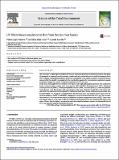Por favor, use este identificador para citar o enlazar a este item:
http://hdl.handle.net/10261/129960COMPARTIR / EXPORTAR:
 SHARE SHARE
 CORE
BASE CORE
BASE
|
|
| Visualizar otros formatos: MARC | Dublin Core | RDF | ORE | MODS | METS | DIDL | DATACITE | |

| Título: | UV filters bioaccumulation in fish from Iberian river basins |
Autor: | Gago-Ferrero, Pablo CSIC ORCID; Díaz-Cruz, M. Silvia CSIC ORCID; Barceló, Damià CSIC ORCID | Palabras clave: | Bioaccumulation/biomagnification Fish HPLC-MS/MS Iberian Rivers UV filters Sediment |
Fecha de publicación: | 5-jun-2015 | Editor: | Elsevier | Citación: | Science of the Total Environment | Resumen: | The occurrence of eight organic UV filters (UV-Fs) was assessed in fish from four Iberian river basins. This group of compounds is extensively used in cosmetic products and other industrial goods to avoid the damaging effects of UV radiation, and has been found to be ubiquitous contaminants in the aquatic ecosystem. In particular, fish are considered by the scientific community to be the most feasible organism for contamination monitoring in aquatic ecosystems. Despite that, studies on the bioaccumulation of UV-F are scarce. In this study fish samples from four Iberian river basins under high anthropogenic pressure were analysed by liquid chromatography-tandem mass spectrometry (HPLC-MS/MS). Benzophenone-3 (BP3), ethylhexyl methoxycinnamate (EHMC), 4-methylbenzylidene camphor (4MBC) and octocrylene (OC) were the predominant pollutants in the fish samples, with concentrations in the range of ng/g. dry. weight (d.w.). The results indicated that most polluted area corresponded to Guadalquivir River basin, where maximum concentrations were found for EHMC (241.7. ng/g. d.w.). Sediments from this river basin were also analysed. Lower values were observed in relation to fish for OC and EHMC, ranging from below the limits of detection to 23. ng/g. d.w. Accumulation levels of UV-F in the fish were used to calculate biota-sediment accumulation factors (BSAFs). These values were always below 1, in the range of 0.04-0.3, indicating that the target UV-Fs are excreted by fish only to some extent. The fact that the highest concentrations were determined in predators suggests that biomagnification of UV-F may take place along the freshwater food web. | Versión del editor: | http://www.ncbi.nlm.nih.gov/pubmed/25777957 | URI: | http://hdl.handle.net/10261/129960 | DOI: | 10.1016/j.scitotenv.2015.03.026 |
| Aparece en las colecciones: | (IDAEA) Artículos |
Ficheros en este ítem:
| Fichero | Descripción | Tamaño | Formato | |
|---|---|---|---|---|
| 10.1016.j.scitotenv.2015.03.026.pdf | 665,19 kB | Adobe PDF |  Visualizar/Abrir |
CORE Recommender
SCOPUSTM
Citations
144
checked on 13-abr-2024
WEB OF SCIENCETM
Citations
130
checked on 25-feb-2024
Page view(s)
184
checked on 23-abr-2024
Download(s)
219
checked on 23-abr-2024
Google ScholarTM
Check
Altmetric
Altmetric
NOTA: Los ítems de Digital.CSIC están protegidos por copyright, con todos los derechos reservados, a menos que se indique lo contrario.
